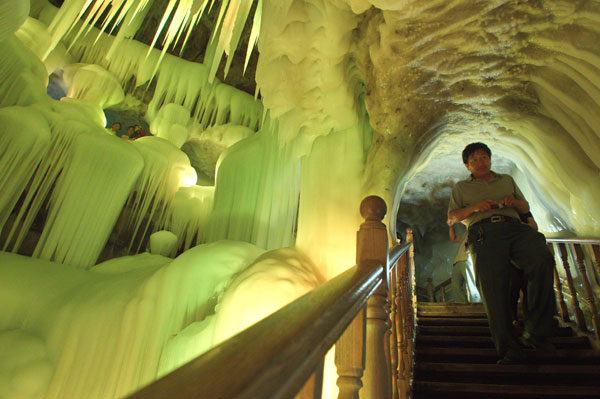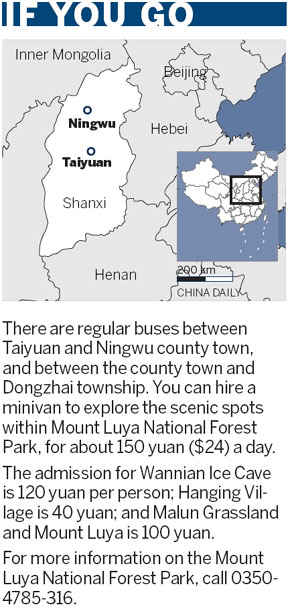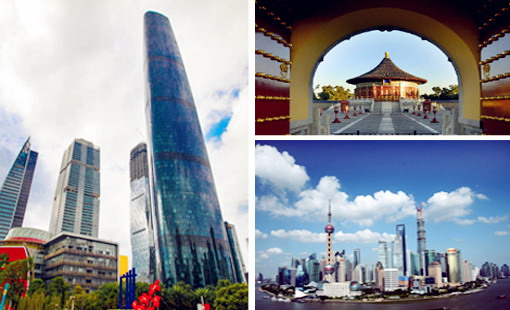Northern exposure
Updated: 2013-08-15 10:33
By Chen Liang (China Daily)
|
||||||||

And it is certainly a surprise to find mature secondary coniferous forests, with tall spruce and pine trees, in an area near the Loess Plateau and in the province known for its rich resources of coal.
With the forests, everything becomes pleasant. The river is clear, flowers are blossoming, birds are chirping and the air is refreshing.
After a half-hour drive, we arrive at Wannian Ice Cave. The admission is 120 yuan ($20) per person, which is not surprising but disappointing. So is the LED screen, with the Chinese name of the cave, on top of a slippery cement tunnel that leads down to the entrance at the bottom of a sheer cliff.
A circuit with wooden steps leads visitors to explore the ice cave. It's like walking into a refrigerator — you feel the icy coldness even before you see the ice.
Yes, there is ice, a lot of it. On walls, on steps, on railings, hanging down from the ceiling like swords, and growing up from the ground like bamboo shoots.
The steps wind down to the cave, which has three levels open to visitors, and then up, into the world made of ice flowers, ice stalactites and stalagmites.
Bathed in light of different hues, they turn the cave into a colorful wonderland.
Later my friend tells me that the cave has a history of more than 3 million years. It is one of the largest ice caves found in the country.
While the ice cave is hidden in a valley of the Guancen Mountains, the Malun Grassland is on one of the mountaintops.
Driving 27 km from the park entrance and up to about 2,400 meters above sea level, we reach the end of the road and see booths selling snacks and drinking water. Sneakers are for rent — probably because too many visitors wear high-heeled shoes to the site and then realize they will need to climb.
After a half-hour hike, trees are suddenly gone and a broad alpine meadow spreads across the top of the slope and stretches into the horizon.
The 400 hectares before us are covered with a lush growth of green grass. Dozens of horses graze at their ease. In this season, various kinds of alpine flowers are in bloom. Pipits and rosefinches are breeding on the grassland.
At the top of the meadow, I see Mount Luya rising in front of me, across a broad valley.
With more than 200 rock peaks and rising 2,739 meters above sea level, Mount Luya is the summit of the Guancen Mountains and the major attraction in the forest park.
It will take a hardy hiker four hours to scale the summit and back to the meadow.
We don't have much time, but we sit in the meadow for a while and enjoy the spectacular panoramic views.
On the way back, I start thinking it's a shame that such a nice area has no lodging, no shuttle buses and no bike rental. That's the reality of traveling in many partsof North China, but it also means there are not big crowds of tourists with you.

 'Despicable' minions upset Depp's 'Lone Ranger' at box office
'Despicable' minions upset Depp's 'Lone Ranger' at box office
 'Taken 2' grabs movie box office crown
'Taken 2' grabs movie box office crown
 Rihanna's 'Diamonds' tops UK pop chart
Rihanna's 'Diamonds' tops UK pop chart
 Fans get look at vintage Rolling Stones
Fans get look at vintage Rolling Stones
 Celebrities attend Power of Women event
Celebrities attend Power of Women event
 Ang Lee breaks 'every rule' to make unlikely new Life of Pi film
Ang Lee breaks 'every rule' to make unlikely new Life of Pi film
 Rihanna almost thrown out of nightclub
Rihanna almost thrown out of nightclub
 'Dark Knight' wins weekend box office
'Dark Knight' wins weekend box office
Most Viewed
Editor's Picks

|

|

|

|

|

|
Today's Top News
Gold rises on physical buying from Asia
Snowden case not to affect US-Russia talks
Abe rules out visit to Yasukuni shrine
Over 200 dead after Egypt forces crush protesters
Manning 'sorry' for US secrets breach
China to probe foreign automakers
Millionaires hold dimmer view
2 killed in crash of UPS cargo jet
US Weekly

|

|





